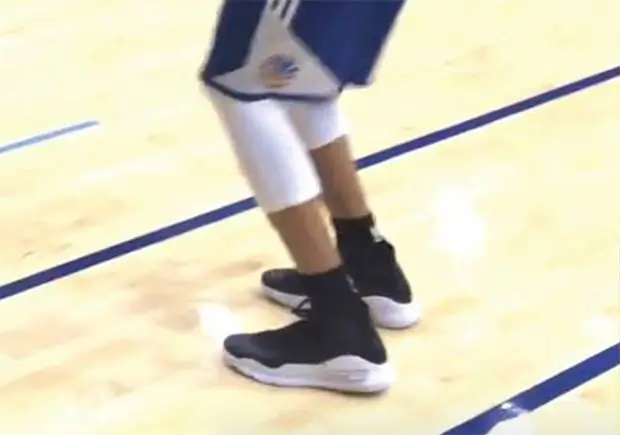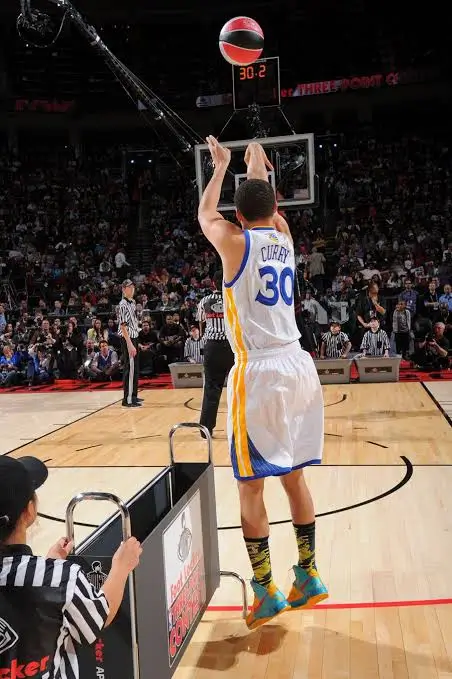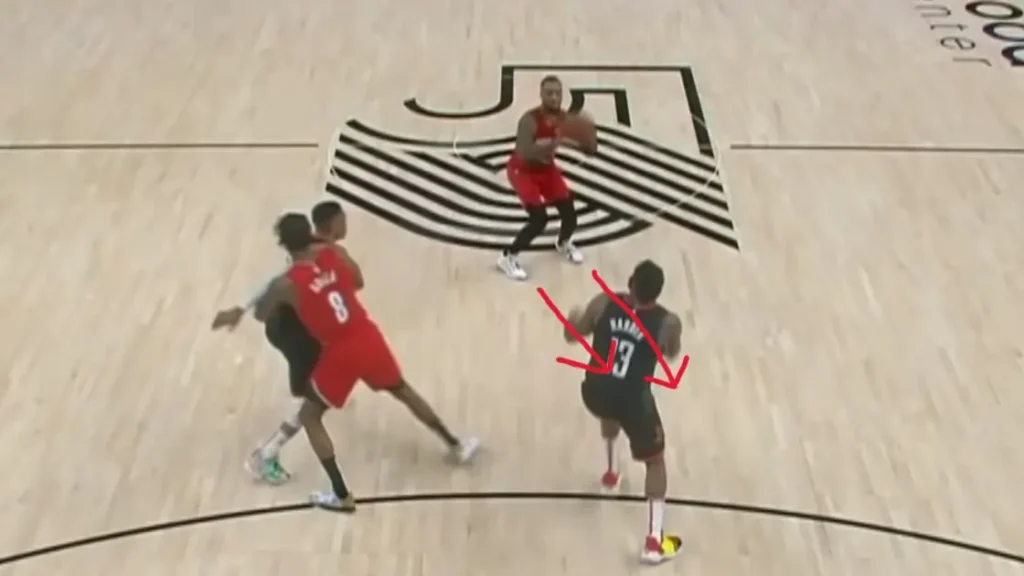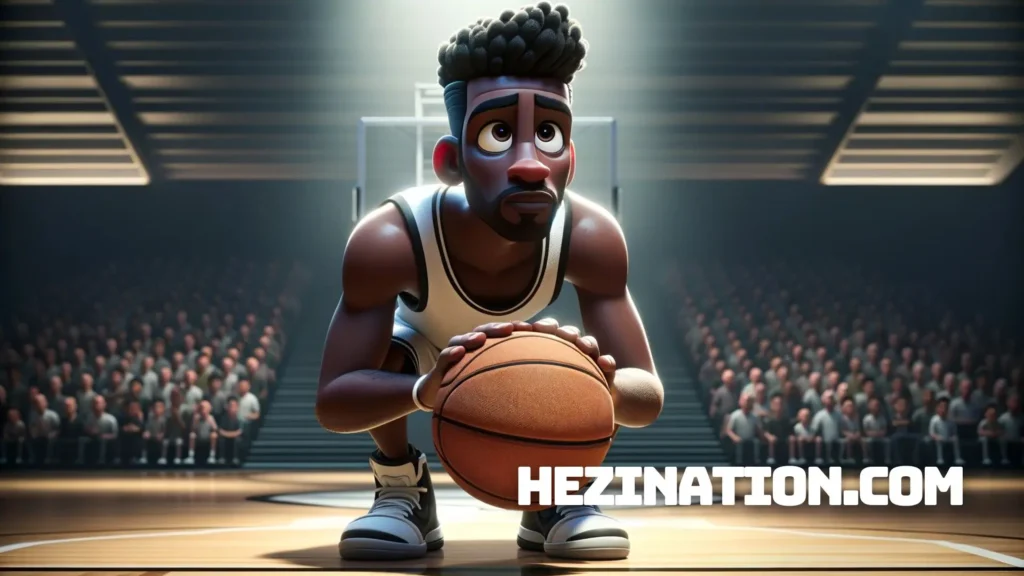Mastering the proper basketball shooting form is key to becoming a better player. A player who shoots precisely and consistently changes the game.
Below is a detailed guide to the basketball shooting fundamentals.
1. Develop your stance and maintain your balance
The principle of stance and balance is fundamental to a perfect basketball shot. Perfecting stance and balance boosts your shooting accuracy.
Develop your stance
Position your feet shoulder-width apart. This width provides stability, ensuring you’re neither too spread out (which can strain the muscles) nor too narrow (which can make you unstable).
Put your front foot a bit ahead of the back one. Keep your feet in a comfortable staggered stance. Feet often point 10 to 15 degrees to either side of the basket.
One thing that I’ve noticed about the top shooters in the world, like Stephen Curry and Damian Lillard, is that their feet are never 100% facing the basket.




“Your feet should be shoulder-width apart. If you’re right-handed, your right foot should be slightly in front of the left. Technically, my feet are slightly off-center, but they face the same direction.”
– Stephen Curry (in an interview with Forbes)
Place your weight on the balls of your feet. This weight shift helps you spring into the shot and smoothly move from catching to shooting.
Slightly bend your knees for power. They store energy as you gather for the shot and release it as you go up, giving power, especially for jump shots.
Maintain your balance
Upper Body Position: Your chest should be upright, and your shoulders should be in line with your feet. Leaning too far forward or backward can throw off your shot.
Head Position: Your head should remain steady, with your eyes focused on the target. A steady head position helps maintain your body’s overall balance.
Guide Hand: While your shooting hand does most of the work, your guide hand (non-shooting hand) plays a crucial role in maintaining balance.
It should be on the side of the ball, ensuring the ball doesn’t wobble during the shooting motion
2. Develop your grip and hand placement
A good grip gives you more control over the basketball, while the correct hand placement gives the ball its backspin, affecting its arc and likelihood of scoring.
Be mindful of your grip
Place the ball on your shooting hand. This is the main hand you use.
Place the ball on your fingertips and hand pads. This forms a small air pocket below. Holding the ball this way gives better control and lowers the risk of side spins.
The gap between the ball and palm also means fingers power the shot, giving more control.
When gripping the ball, the shooting hand’s thumb is crucial. Spread the thumb out to form a “V” shape with the index finger. This shape adds stability to the shot.
Calibrate your hand placement
Position your hands to form a 45-degree angle, with the shooting hand below the ball and the guiding hand on the side. Such a hand position ensures the ball’s stability during the shot.
The non-shooting hand, also known as the guide hand, supports the ball from the side. This hand aids in balancing the ball during the shot and keeps its path straight.
The guide hand shouldn’t change the shot’s path or spin.
When releasing the ball, let it roll off your fingertips. Start with the middle and ring fingers, then the index and little finger. Using this finger sequence gives the ball the right backspin.
Avoid these mistakes
Palm Shooting: Letting the ball rest heavily on the palm reduces control and gives it a bad spin. Always keep a gap between your palm and the ball.
Guide Hand Interference: Pushing the ball with the guide hand during a shot can cause a side spin. The guide hand should support the ball and move aside smoothly as you release.
3. Focus on your target
While the ultimate goal is to get the ball through the hoop, pick a smaller target like the back of the rim or the center of the hoop. This increases your accuracy.
Choose the right target
Back of the Rim: Aiming for the back of the rim gives a clear visual target. This is especially helpful for long-range shots. However, you might hit the ball too hard and overshoot.
Center of the Hoop: Visualizing the hoop’s center helps create a shot arc. A ball shot with a higher arc has a better chance of going in due to the larger entry angle.
Front of the Rim: Some players focus on the rim’s front to avoid short shots and ensure the ball reaches the basket. This focus might result in a flatter shot trajectory.
There is a study involving 24 expert and 24 amateur basketball players.
The study revealed that experts, aiming at the hoop’s front edge, had an FG% of 83.47%. In contrast, amateurs, aiming at the central or back edge, achieved only 34.86% FG%.
Aim at the rim hooks (like Stephen Curry)
To adopt the shooting form of the world’s best shooter, aim at the rim hooks before shooting.
Stephen Curry mentions his target when shooting: the rim hooks. Unlike most NBA players, the pro doesn’t aim at the square on the backboard behind the net. He also doesn’t aim at the rim.
The rim hooks are what connect the net to the rim. His technique involves focusing on the two or three rim hooks facing him. He then visualizes dropping the ball just over the rim’s front.
4. Develop your shooting motion
As with many sports, power comes from the legs. Start your shot by bending your knees and using the strength of your legs to push the ball.
Your shooting motion should be one fluid movement. Extend your legs, and let your arms move smoothly. Release the ball when you’re at the highest point of your jump.
Craft your shooting motion
Understanding the shooting motion requires breaking it down into its core components:
Gathering the Ball: The first step is gathering the ball before you start the shot. This means you move from dribbling or catching a pass to the shooting stance. A smooth gather sets the tone for a fluid shot.
Power Generation: The legs, especially the thighs and calves, act as the primary power source. Bend your knees first. When you extend them, you create the force needed for the shot, which is vital for long shots.
The Upward Swing: When the legs extend, the shooting arm starts moving up. At this time, the elbow is bent and the ball is in the shooter’s pocket. This coordinated action between the legs and the arm is crucial for shot consistency.
Release: During a jump shot, at its highest point, the wrist flicks. The fingers then direct the ball, setting its path, curve, and spin.
Make your shot as fluid as possible
One Continuous Motion: The shooting motion should feel like one seamless action. Any hitch or pause can disrupt the shot’s accuracy. Power starts in the legs, moves up the body, then goes through the arm. Finally, it leaves the fingertips to push the ball to the basket.
Synchronization: It’s vital to synchronize the legs (lower body) with the arms and wrist (upper body). A shot may lack power if the legs extend before the arm moves. But if the arm moves before the legs extend, the shot could rise high and then not reach far enough.
5. Follow-through after a shot
A follow-through is the act of completing the shooting motion even after the ball leaves a player’s hand.
The follow-through is crucial for proper shooting form. It greatly affects the shot’s accuracy, consistency, and effectiveness.
There are three components for a successful follow-through:
Wrist Relaxation and Finger Extension: After releasing the ball, relax your wrist and give a downward flick in a smooth action. Keep your fingers extended, pointing to the basket. The extended fingers and relaxed wrist resemble a “goose neck.”
Eyes on the Prize: Keep your eyes on the target even after releasing the ball. This focus emphasizes the importance of aiming.
Holding the Pose: Maintain your shooting pose until the ball reaches the basket. This promotes discipline and ensures the motion is completed correctly.
Don’t neglect your follow-through
You need the follow-through because of three things:
Backspin: A proper follow-through gives the ball the right backspin. This makes the ball bounce softly off the rim or backboard, which improves its chances of going in.
Direction: Extending the fingers straight ensures the ball moves in a straight path. Deviating in the follow-through can make the ball go off-course.
Muscle Memory: A consistent follow-through reinforces muscle memory, ensuring that each shot is as uniform as possible.
Until you’re a consistent shooter, it’s hard to spot and fix mistakes if you lower your hands immediately after shooting.
6. Practice to develop muscle memory
Like any skill, the key to mastering your shooting form is repetition. The more you practice, the more natural your shot will feel.
When you practice enough, your shooting changes from a controlled action to an instinctive one. This shows muscle memory, as the body learns the movement.
When your muscle memory learns the shooting motion, you can shoot faster and more efficiently, which is key for games.
With time, your muscles learn the right form, making shooting become second nature.
Once shooting is second nature, you won’t focus just on your shot form. You can pay attention to game strategy and watch opponent movements.
Keep in mind that top players always practice to perfect their shooting form. So grab a ball, head to the court, and start practicing!
Once you master the proper basketball shooting form, you can learn other basketball shot types.
